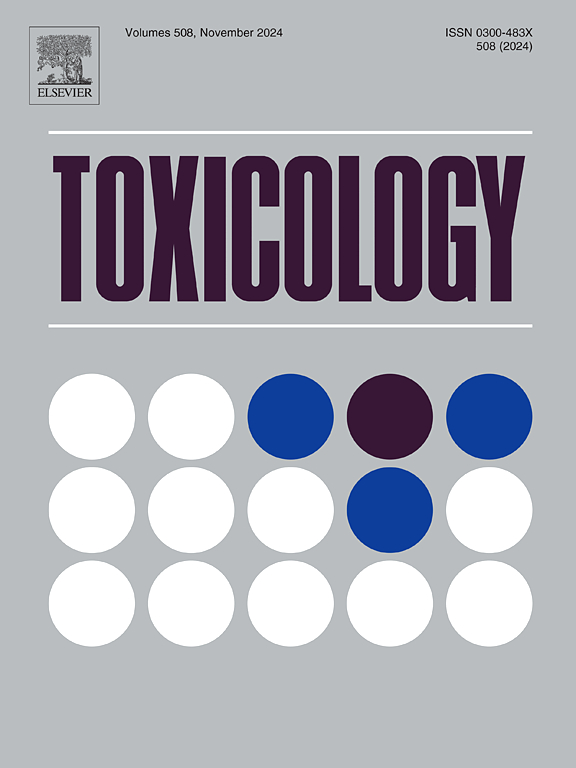DockTox:通过分子对接靶向器官毒性的分子起始事件
IF 4.8
3区 医学
Q1 PHARMACOLOGY & PHARMACY
引用次数: 0
摘要
毒理学中的不良后果途径(AOPs)描述了从化学物质暴露到不良后果的关键事件序列,促进了预测模型的发展。欧盟ONTOX项目使用这一框架来预测肝脏、发育中的大脑和肾脏的毒性,而无需进行动物试验。专注于分子启动事件(MIEs),更具体地说,是化学物质与关键蛋白质的相互作用,我们开发了一个自动化的工作流程,将小分子对接到超过20个预处理蛋白质结构上,在在线工具DockTox中实现。该工具生成小分子构象,对mie相关蛋白进行对接,并提供结合能、相互作用残基和相互作用图。此外,它将相互作用与已知配体的参考列表进行比较,产生相互作用分数作为额外的相似性度量。对接流程对过氧化物酶体增殖体激活受体α (PPARα)的预测性能评估表明,相互作用分数值比单独的结合能更能区分结合物和非结合物。这一独特的特征增强了对靶蛋白相互作用的理解。DockTox支持针对mie相关蛋白的小分子虚拟筛选,提供结合能和相互作用谱的见解。它是在分层风险评估方法中预测化学品暴露不良后果的有价值的工具。本文章由计算机程序翻译,如有差异,请以英文原文为准。
DockTox: Targeting molecular initiating events in organ toxicity through molecular docking
Adverse Outcome Pathways (AOPs) in toxicology describe the sequence of key events from chemical exposure to adverse outcomes, facilitating the development of predictive models. The EU ONTOX project uses this framework to predict liver, developmental brain, and kidney toxicity without animal testing. Focusing on Molecular Initiating Events (MIEs), more concretely on the interaction of chemicals with key proteins, we have developed an automated workflow for docking small molecules onto over 20 pre-processed protein structures, implemented in the online tool DockTox. This tool generates conformers of small molecules, performs docking on MIE-associated proteins, and provides binding energy, interacting residues, and interaction maps. Additionally, it compares the interactions to a reference list of known ligands, producing an interaction fraction as an additional similarity measure. Evaluation of the docking workflow’s predictive performance on Peroxisome Proliferator-Activated Receptor α (PPARα) showed that interaction fraction values are more informative than binding energy alone for distinguishing binders from non-binders. This unique feature enhances the understanding of target protein interactions. DockTox supports the virtual screening of small molecules targeting MIE-associated proteins, offering insights into binding energies and interaction profiles. It is a valuable tool for anticipating adverse outcomes from chemical exposure in a tiered risk assessment approach.
求助全文
通过发布文献求助,成功后即可免费获取论文全文。
去求助
来源期刊

Toxicology
医学-毒理学
CiteScore
7.80
自引率
4.40%
发文量
222
审稿时长
23 days
期刊介绍:
Toxicology is an international, peer-reviewed journal that publishes only the highest quality original scientific research and critical reviews describing hypothesis-based investigations into mechanisms of toxicity associated with exposures to xenobiotic chemicals, particularly as it relates to human health. In this respect "mechanisms" is defined on both the macro (e.g. physiological, biological, kinetic, species, sex, etc.) and molecular (genomic, transcriptomic, metabolic, etc.) scale. Emphasis is placed on findings that identify novel hazards and that can be extrapolated to exposures and mechanisms that are relevant to estimating human risk. Toxicology also publishes brief communications, personal commentaries and opinion articles, as well as concise expert reviews on contemporary topics. All research and review articles published in Toxicology are subject to rigorous peer review. Authors are asked to contact the Editor-in-Chief prior to submitting review articles or commentaries for consideration for publication in Toxicology.
 求助内容:
求助内容: 应助结果提醒方式:
应助结果提醒方式:


